
Invisalign® clear aligners provide a discreet, modern alternative to traditional braces for many patients who want a straighter smile without the look and feel of metal wires. Using precise digital planning and a sequence of custom-made aligners, this system gradually guides teeth into improved positions while allowing you to keep your daily routine largely unchanged.
Patients appreciate how aligners combine clinical predictability with the convenience of removability. Below we explore how Invisalign® works, who is a good candidate, what to expect during treatment, and practical tips to make the process as smooth as possible.
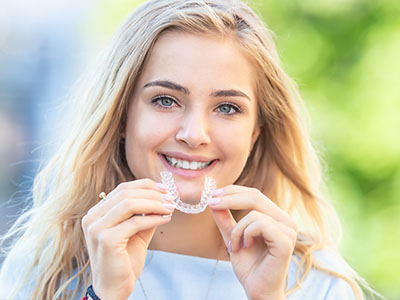
Invisalign® for Teens

Invisalign® for Brides

Invisalign® for Travelers
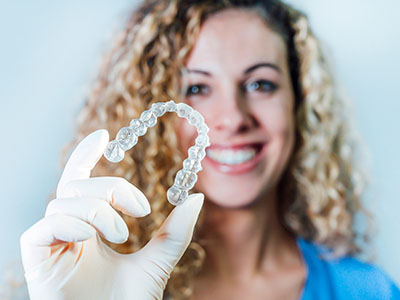
Before & After Photos
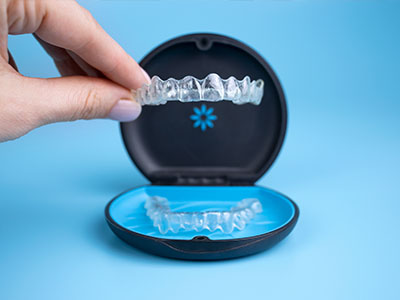
Invisalign® Videos
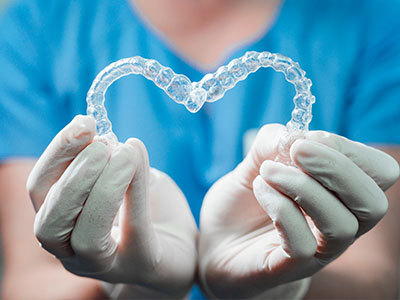
FAQs
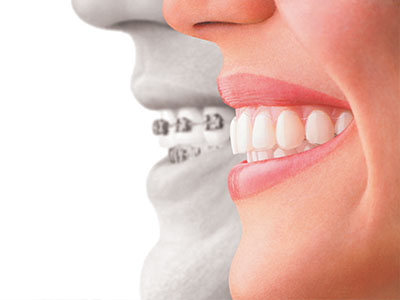
Invisalign® vs Braces
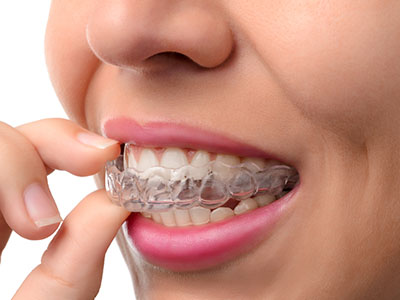
Invisalign® vs Direct-To-Consumer Aligners
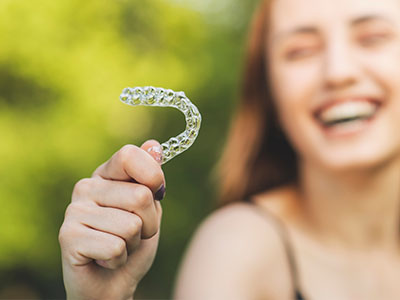
Is Invisalign® Right For Me?
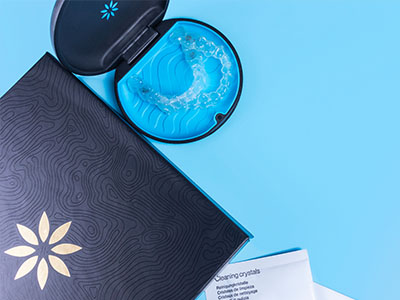
Invisalign® Costs
Invisalign® treatment begins with a detailed digital assessment of your bite and tooth positions. Advanced 3-D imaging and software allow clinicians to visualize a step-by-step plan for movement, breaking the overall goal into a series of small, controlled shifts. Each aligner in the series applies light, targeted force to specific teeth so movement is gradual and measurable.
This computer-guided approach gives both the dentist and patient a clear roadmap. The treatment plan anticipates the sequence of aligners needed and predicts how the teeth will respond. That predictability helps clinicians monitor progress and make adjustments when refinement is necessary.
Because the forces involved are modest and applied over longer periods, many patients experience less discomfort than with traditional braces. Attachments (small, tooth-colored bumps) are sometimes placed on specific teeth to help the aligners achieve complex movements—these are temporary and designed to work with the aligner system rather than to alter daily appearance.
Invisalign® addresses a wide range of alignment issues, including mild to moderate crowding, spacing, and many bite irregularities. Adults who want a discreet solution and teens who are motivated to maintain responsible wear schedules often find aligners especially appealing. The system supports a natural-looking orthodontic experience that fits into work, school, and social life.
Not every case is ideal for aligner-only treatment; some complex skeletal or severe bite problems may require traditional braces or a combined orthodontic and restorative approach. During a clinical evaluation, your dentist will review your goals, examine occlusion and jaw health, and recommend the safest, most effective path forward—whether that means Invisalign® or an alternative form of care.
Good candidates are committed to wearing aligners most of the day (typically around 20–22 hours) and maintaining regular visits for progress checks. Success relies on a partnership between clinician and patient: careful planning, consistent wear, and open communication ensure the best possible outcome.
The process starts with a consultation and diagnostic stage. Your provider captures digital scans or impressions and takes photographs and X-rays as needed. These records feed into a customized treatment plan, which maps each stage of movement and produces a virtual preview of expected changes.
Once your aligners are manufactured, you’ll begin wearing a new set every one to two weeks as directed. Routine appointments are scheduled to confirm that your teeth are moving as planned and to address any questions. If the results vary from the original projection, the plan can be refined with additional aligners to fine-tune alignment.
At the end of active treatment, retention is a crucial step. Retainers—often a removable clear appliance similar to an aligner—help preserve the new tooth positions while supporting long-term stability. Your dentist will recommend a retention plan that matches the specifics of your case and lifestyle.
At Lesley Holloway the Dentist, we guide patients through each stage with clear explanations and attention to comfort, ensuring the technical steps are easy to follow and tailored to your needs.
One of the biggest advantages of removable aligners is convenience. You can take them out to eat and to brush and floss, which simplifies oral hygiene compared with fixed brackets. Still, good habits matter: keeping aligners clean, storing them safely when removed, and brushing after meals before reinserting them will help prevent staining and maintain oral health.
Your speech may adjust for a day or two when you first begin wearing a new set of aligners, but most patients adapt quickly. If you play wind instruments or participate in contact sports, discuss protective strategies with your dentist—there are effective options for accommodating performance and safety while staying on track with treatment.
Travel and busy schedules are also manageable with aligners. Carrying a small storage case and a travel toothbrush helps you stay compliant on the go. Because aligners are designed for regular, incremental wear, keeping to the prescribed schedule is the single most important factor in reaching your treatment goals as planned.
Straighter teeth are often easier to clean and maintain. By correcting crowding and improving spacing, aligner therapy can reduce areas where plaque and debris tend to accumulate, supporting healthier gums and lowering the risk of cavities caused by difficult-to-reach spots.
Improved bite relationships can also distribute chewing forces more evenly, which helps protect tooth enamel and may reduce abnormal wear. In cases where malalignment contributes to jaw discomfort or inefficient chewing, orthodontic correction with aligners can be part of a broader strategy to restore function and comfort.
Aligners are also compatible with many other dental treatments. Whether restoring a worn tooth, replacing a missing tooth with an implant, or coordinating with periodontal care, the orthodontic plan can be integrated into comprehensive treatment, helping patients achieve both healthy function and pleasing aesthetics.
Custom-made to the exact specifications of your smile, Invisalign® clear aligners are designed to incrementally move your teeth into their correct positions over time. Simply swap-out last week's aligner for the next one in the series and watch as your smile progressively shows signs of improvement.
And, because Invisalign® clear aligners are removable for short periods of time, you can still enjoy the foods you love as well as brush and floss your teeth with ease!

Start with a clinical review that assesses alignment, bite, and overall oral health. This consultation helps determine whether aligner therapy is a suitable approach for your individual needs.
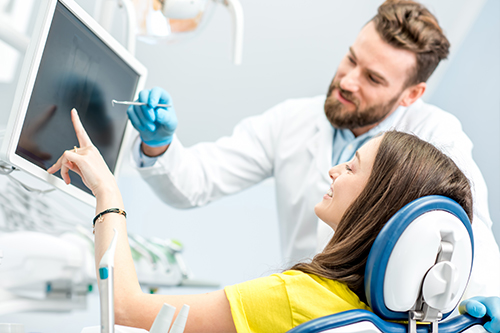
A precise digital scan guides a customized treatment map that shows the expected sequence of movements and gives you a preview of potential results before treatment begins.
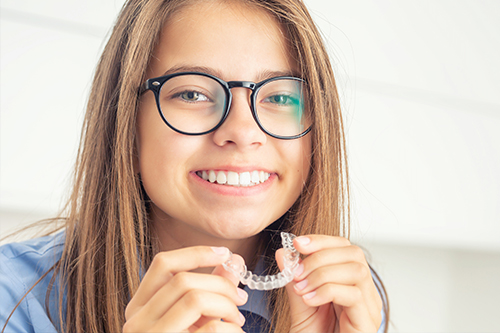
Each set of aligners is formed to fit your teeth precisely. Built with patient comfort in mind, they work discreetly and efficiently as part of a planned progression.

After active alignment, retainers help stabilize your new tooth positions. Your dentist will recommend a retention schedule that supports long-term success.
Explore the true stories and journeys of several Invisalign® patients
*Invisalign® is a registered trademark of Align Technology, Inc.
Ready to learn whether Invisalign® is a good fit for you? Contact Lesley Holloway the Dentist for more information and to schedule a consultation with our team. We’ll explain the process, review your options, and help you decide on the best path for a healthy, confident smile.
Invisalign® clear aligners are a series of custom, nearly invisible trays that gently guide teeth into improved positions. They are removable for eating and oral care, which helps patients maintain regular hygiene and diet during treatment. The system is planned digitally and manufactured to fit each stage of the intended tooth movement.
Unlike traditional braces, Invisalign® applies light, targeted forces with each aligner rather than continuous force from wires and brackets. Removability and a smooth plastic design reduce irritation to soft tissues and simplify daily care. Many cases that involve mild to moderate crowding, spacing, or bite irregularities can be treated effectively with aligners under clinical supervision.
Treatment begins with a detailed digital assessment that captures the current bite and tooth positions. Advanced three-dimensional imaging and treatment-planning software create a step-by-step map of the desired tooth movements. That plan is translated into a sequence of aligners, each designed to move specific teeth a small amount.
Wearing each aligner for the prescribed interval produces predictable, measurable progress when combined with regular monitoring. Because movements are broken into many small stages, clinicians can visualize outcomes and make refinements when needed. This staged approach often results in less soreness compared with larger, abrupt adjustments.
Good candidates for Invisalign® typically include adults and responsible teens with mild to moderate alignment concerns such as crowding, gaps, and many bite irregularities. Candidates must be willing to wear aligners most of the day—generally around 20–22 hours—and follow scheduled follow-up visits. Patients with severe skeletal discrepancies or complex jaw alignment issues may require alternative or combined treatment approaches.
A clinical evaluation will assess occlusion, jaw function, gum health, and any restorative needs before recommending aligner therapy. Your dentist may recommend adjunctive treatments or a referral to a specialist when appropriate to achieve the safest, most stable result. Commitment to the prescribed wear schedule and oral-care routine is a major factor in treatment success.
The Invisalign® journey starts with a consultation, digital scans, and any necessary X-rays or photographs to document tooth and jaw relationships. These records allow your clinician to produce a customized treatment plan and a virtual preview of expected tooth movement. After the aligners are fabricated, patients typically switch to a new set every one to two weeks while attending periodic progress appointments.
Routine monitoring ensures the case remains on track and identifies when refinements are needed. At Lesley Holloway the Dentist, we explain each step so patients understand timing, responsibilities, and what to expect during active treatment. When active alignment is complete, a retention plan—usually a removable retainer—helps preserve the results and supports long-term stability.
Keep aligners clean by rinsing them when removed and brushing them gently with a soft brush and cool water or a manufacturer-recommended cleanser. Avoid hot water, which can warp the plastic, and do not use abrasive toothpaste or harsh chemicals that can scratch or discolor the aligners. Store aligners in a protective case whenever they are not in use to prevent loss or damage.
Maintain excellent oral hygiene by brushing and flossing after meals before reinserting aligners to reduce staining and bacterial buildup. Carry a compact toothbrush and a travel case to stay compliant when you are away from home. Consistent wear and good cleaning habits help keep treatment on schedule and protect oral health.
Most patients experience mild pressure or soreness for a day or two when starting a new set of aligners as teeth begin to move. This sensation typically diminishes after the initial adjustment period and is often less intense than discomfort from larger adjustments with braces. Over-the-counter pain relievers and soft foods can help manage temporary soreness when needed.
Some patients notice a brief change in speech, such as a slight lisp, when first wearing aligners; this usually resolves within a few days as the tongue adapts. If you play a wind instrument or rely on precise speech for work, discuss strategies with your dentist to minimize disruption. For contact sports, ask about protective options that accommodate your aligners or recommend a suitable mouthguard.
Attachments are small, tooth-colored composite bumps bonded to selected teeth to give aligners a better grip for rotations, extrusions, or complex movements. They are placed during treatment and removed when their function is complete, leaving the tooth surface intact. Attachments are designed to be discreet and blend with the natural tooth color.
Not all cases require attachments; their use depends on the specific biomechanics needed to achieve the prescribed movements. When attachments are indicated, they increase the predictability of certain tooth movements that aligners alone may struggle to accomplish. Your dentist will review their purpose and expected duration before placement.
Invisalign® can be coordinated with many other dental treatments, including restorations, implants, and periodontal care, to achieve both functional and aesthetic goals. Treatment sequencing is important; orthodontic movement may precede or follow restorative procedures depending on the case plan. Close collaboration between the general dentist, specialists, and the patient ensures that each phase supports the overall treatment objectives.
In cases that require surgical correction or complex bite adjustment, a combined orthodontic and restorative plan may be necessary to achieve optimal results. Digital planning helps clinicians visualize how restorative work will integrate with tooth movement and final occlusion. Clear communication and timely follow-up appointments reduce surprises and keep multidisciplinary plans coordinated.
Retention is the phase after active tooth movement during which retainers hold teeth in their new positions while surrounding tissues adapt. Most patients receive removable clear retainers similar in form to aligners, and many begin with full-time wear that transitions to nightly use over time. The precise retention schedule varies by case and the amount of movement performed.
Long-term commitment to retention is essential because teeth can shift throughout life. Your dentist will outline a retention plan tailored to your needs and may recommend periodic recall visits to verify stability. If minor relapse occurs, additional orthodontic options or refinements can often correct changes efficiently.
To schedule an Invisalign® consultation with Lesley Holloway the Dentist, call (402) 256-3231 or use the Book Appointment option on our website. Our office is located at 124 E 2nd St., Laurel, NE 68745 and offers appointments Monday through Thursday from 8 a.m. to 4:30 p.m. The initial visit typically includes a clinical exam and digital scans to determine candidacy and to develop a treatment plan.
Bring a list of current medications and any relevant dental records or X-rays you already have to help streamline the evaluation. During the consultation the team will review treatment options, explain next steps, and answer your questions about daily care and scheduling. If further diagnostic records are needed, the staff will explain that process and set expectations for follow-up.
Quick Links
Contact Us